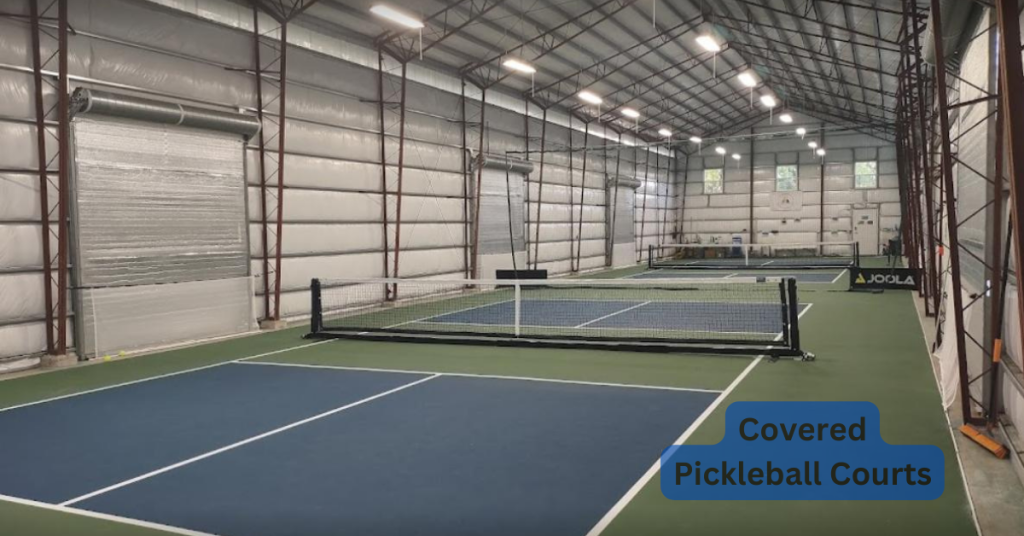
Pickleball is one of the fastest-growing sports in the United States, with millions of players enjoying this fun paddle sport. As pickleball’s popularity continues to rise, many players are looking to enhance their playing experience by utilizing covered pickleball courts. Covered courts provide pickleballers with shade, shelter from the elements, and the ability to play year-round regardless of the weather. If you’re interested in installing covered courts at your home, community, or pickleball facility, here’s what you need to know.
Covered Pickleball Courts Near Me
Chapters
ToggleInstalling covered pickleball courts allows you to play pickleball rain or shine. If you’re looking for covered pickleball courts near your location, start by searching online directories and apps like Pickleball Connect to find courts with coverings nearby. You can also check with your local parks department, schools, community centers, YMCAs, or private sports clubs to see if they have covered pickleball facilities available. As the sport grows, more and more public and private venues are building designated pickleball courts, often with shade structures or indoor facilities to allow for year-round play. Finding covered pickleball courts near you is becoming easier than ever.
Covered Pickleball Courts Price
If you’re looking to build covered pickleball courts yourself, either at your home or for a business, club, or community facility, the price can vary greatly depending on the type of structure you construct. Some ballpark figures:
- Basic shade sails or tarps to cover one or two courts: $3,000-$6,000
- Metal, wood, or aluminum structure over 2-4 courts: $15,000-$40,000
- Large fabric tension membrane structure for 6+ courts: $50,000-$150,000
- Enclosed permanent building for 4+ courts: $200,000-$500,000+
The most budget-friendly options are basic shade sails, tarps, and canopies that can cover one or two courts to provide basic sun protection. More permanent structures like wood or metal-frame buildings, or fabric tension membrane structures, allow for covering multiple courts while still letting in natural daylight. Fully enclosed buildings provide maximum weather protection for year-round play but are the biggest investment.
Covered Pickleball Courts for Sale
If you want to purchase and install a complete covered pickleball court system, there are a few companies that manufacture and sell them:
- Douglas Industries offers pre-fab metal buildings for covered pickleball courts. Their buildings can cover 2-8 courts and start around $100,000.
- SprinTurf sells modular outdoor court tiles and shade sails that can create A 2-court system starting at around $30,000.
- Networld Sports is a UK-based company that sells a variety of pickleball equipment, including covered pickleball court systems. Their systems are made from durable materials and can be customized to fit any size court.
- Shelter Systems is a US-based company that specializes in the design and construction of covered pickleball courts. They offer a variety of options to choose from, including permanent and temporary structures.
- Coversports is a Canadian company that manufactures and sells covered pickleball courts. Their courts are made from high-quality materials and are designed to withstand the elements.
Purchasing a pre-designed covered pickleball court package can save costs compared to building a custom structure. Just keep in mind that site preparation, foundations, electrical, permits, installation, etc. will add to the total project cost.
Pickleball Court Shade Structure Options
If you’re looking for a more affordable way to get shade on your pickleball courts, here are some shade structure options:
- Sails – triangle, square, or rectangle shades made from canvas or mesh material. Easy to install and remove. Approx. $3000-$5000 per sail.
- Umbrellas – cantilever, center pole, or side post umbrellas. Provide targeted shade. $2500-$5000 each.
- Pavilions – open-air structures with roofing on columns or posts. Start around $10,000 for a basic 20′ x 20′ pavilion.
- Awnings – retractable or fixed aluminum awnings. Attach to court fencing or walls. $4000-$7000 per court.
- Canopies – like tents, but more heavy-duty. Available in various sizes with either legs or tie-downs. $3000-$8000 per canopy.
Shade sails, umbrellas, and canopies can provide economical shade for pickleball courts. Pavilions and awnings offer more permanent cover. All should be designed to withstand wind and weather at your location.
Pickleball Court Tarp Options
For temporary shade or rain protection, tarps are an affordable option to cover one or more pickleball courts. Some tarp types include:
- Canvas tarps – Made from durable canvas material. Water-resistant and long-lasting. Eyelets allow securing to posts or fencing. $200-$500 per 10’x10′ tarp.
- Mesh tarps – Made from woven polyethylene material that blocks the sun while allowing airflow. Lightweight and easy to secure. $100-$300 per 10’x10′ tarp.
- Vinyl tarps – Made from waterproof vinyl-coated polyester. Resists mold and mildew. $100-$400 per 10’x10′ tarp.
- Poly tarps – Low-cost light-duty tarps made from polyethylene sheeting. $50-$150 per 10’x10′ tarp.
Multiple tarps can be combined to cover full courts. Grommets allow securing tarps to poles, fencing, or anchors on windy days. Tarps need to be removed and stored when not in use.
Indoor Pickleball Court Height Requirements
When constructing indoor pickleball courts, you’ll need to consider the height of your ceiling. The minimum recommended ceiling height for indoor pickleball is 20 feet, but 30 feet is ideal. This allows adequate space above the court for lob shots. If the ceiling height is under 20 feet, you may need to use low dead balls rather than regular balls and be prepared for more balls to hit the ceiling. Anything lower can obstruct play.
Lighting is also a factor – you’ll need at least 50-foot candles of illumination for recreational play. For tournaments, 100-foot candles may be required. Install lights high enough not to obstruct play but bright enough for tracking the ball.
Good ventilation, fans, and AC will help keep an indoor pickleball facility comfortable. Having enough space around the court perimeter for safe movement is also advised. Overall, maximize height and lighting as much as possible when building indoor pickleball courts to optimize playability.
With its fun, social nature, and minimal equipment needs, it’s no wonder pickleball is booming. Covered and indoor courts allow for more playing time year-round. Whether you invest in permanent pickleball structures or more flexible shade solutions, covered courts let the games go on regardless of the weather.
FAQs
Yes, covered Pickleball courts are designed to provide all-weather play, protecting players from rain, sun, and other weather conditions. This makes them ideal for year-round enjoyment.
Common materials for covering Pickleball courts include fabric membranes, metal structures, and high-quality roofing materials. These materials are chosen for their durability, weather resistance, and longevity.
Covered Pickleball courts typically require regular inspections and cleaning of the covering materials. However, specialized maintenance is often minimal, contributing to the convenience of having a covered court.
Yes, the covering of Pickleball courts can be customized to meet aesthetic preferences and suit specific environments. There are various design options and materials available, allowing for customization based on individual preferences and the surrounding landscape.
Yes, covered Pickleball courts can be equipped with additional amenities like lighting systems for evening play and comfortable seating areas. These enhancements contribute to an enhanced playing experience and overall enjoyment of the facility.
Yes, covered Pickleball courts can be designed for both indoor and outdoor locations. The versatility of these courts makes them adaptable to different settings, providing a covered playing space wherever needed.
Sharing is caring!
